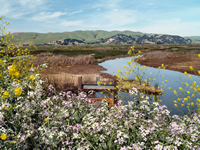Programs:
Compliance and Evaluation
- Aquatic Ecology
- Bay Delta Monitoring and Analysis
- Environmental Real Time Monitoring
- Feather River Program
- Interagency Ecological Program (IEP)
- Special Studies Research
Water Quality
Planning
Restoration
- Delta Fish Agreement
(Four Pumps) - Habitat Expansion Plan (Final)
- Habitat Restoration (HEA)
- Implementation Strategy - FRPA (Draft)
Invasive Species
About
- Environmental Services Home
- Who we are
- Related Links & Information
- Contact Us
- DWR Calendar
- DWR Publications

Environmental Services
3500 Industrial Blvd.
West Sacramento, CA 95691
(916) 376-9701
Mailing Address:
P.O. Box 942836
Sacramento, CA 94236-0001
| Overview of California’s
Zebra Mussel Watch Program The California Department of Water Resources (DWR), on behalf of the CALFED Bay-Delta Program, is conducting a comprehensive project to protect our watershed and water supply from the invasive zebra mussel. The program is composed of several elements: a risk assessment, an early detection monitoring program, a centralized reporting system “How to Report a Zebra Mussel Sighting”, a rapid response plan, and public outreach and education“Outreach Materials”. The risk assessment involves determining which waterbodies in California have a high probability of zebra mussel establishment. High risk areas have suitable zebra mussel habitat (based on substrate type, pH, and mineral availability), appropriate water temperatures for spawning, adequate food supplies, and high levels of boating activity. Early detection monitoring is conducted at high risk rivers and reservoirs in the Central Valley watershed. Sampling consists of suspending an artificial substrate (link to monitoring pictures) for zebra mussels to attach onto, and then checking this substrate for the presence of zebra mussels every month. The monitoring is conducted by private citizens, marina staff, DWR staff, and staff from other agencies. A centralized system was created for reporting zebra mussel sightings. Sightings can be reported via a toll-free number or email: Phone: 1-888-840-8917 (toll free) Email: mussel@water.ca.gov All reports go directly to staff at the Department of Water Resources in Sacramento, California. Notification of confirmed sightings are distributed by email to interested parties and made available on this website. A rapid response plan is being developed to provide guidelines for zebra mussel sighting confirmation and appropriate eradication measures. This plan will provide a list of regulatory agencies to contact in the event of zebra mussel detection and propose control and eradication strategies. The objectives of the public outreach and education program are to provide information materials to all interested parties on how to identify zebra mussels “What is a Zebra Mussel?”, how to prevent their introduction (e.g., how to properly clean boats) “How to Inspect and Clean Boats and Trailers”, and what to do if zebra mussels are found in California “How to report a sighting”.
|
Early detection monitoring is conducted at high risk rivers and reservoirs in the Central Valley watershed. Sampling primarily consists of suspending an artificial substrate for zebra mussels to attach onto and then checking this substrate for the presence of zebra mussels every month. The artificial substrate consists of a plexiglass plate and 2 PVC pipes filled with fabric mesh. These components are attached to a line of rope that is weighted at one end and can be suspended from a variety of structures located in the waterbody, including boat docks/slips, pipes, and piers. The artificial substrate monitoring is conducted by private citizens, marina staff, DWR staff, and staff from other agencies.
Why Monitor for Zebra Mussels?
Early Detection
The objective of field monitoring is to detect zebra mussels during the initial stage of establishment. In order to eradicate zebra mussels from a waterbody, we need to begin control measures when the population is small and isolated. Early detection is the key to successful eradication. A rapid response plan will be in place and will contain guidelines and instructions for responding to a zebra mussel invasion.
Prevent Spread
Our ability to successfully eradicate or control an infestation of zebra mussels is more feasible and less costly if the population is isolated to a single lake as opposed to widespread in the watershed. Therefore, containing new zebra mussel populations is extremely important. In the event zebra mussels are discovered in a lake, the California Department of Fish and Game, along with other state and federal agencies, will take steps to prevent the mussel from spreading to other lakes and rivers. These steps may include boat cleaning at the infested lake, increasing public education and awareness efforts, and perhaps modifying the use of the infested lake.
Time to Prepare
Early detection provides water facility managers with an early warning system. They have some time to retrofit the facility to ensure uninterrupted water deliveries. Facility managers will need to change facility operating procedures to adapt to and minimize the impacts of zebra mussels. Such measures may include retrofitting intake valves with customized filters designed to screen out mussels, painting irritant coatings on surfaces to prevent mussels from settling, periodically flushing the system with high concentrations of chemicals (such as chlorine) to kill attached mussels, or periodically pressure washing all surfaces with hot water to kill and remove attached mussels. All of these measures are very costly and may require temporary facility shutdowns.






